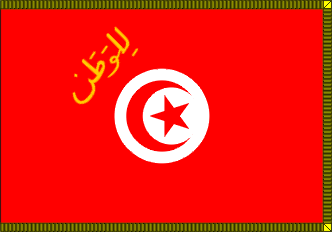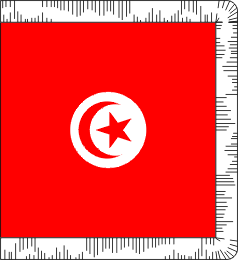

Last modified: 2007-11-17 by rob raeside
Keywords: tunisia | star (white) | crescent |
Links: FOTW homepage |
search |
disclaimer and copyright |
write us |
mirrors
See also:

Similar to the national flag, red flag with white disk containing the
crescent and star (apparently somewhat smaller than in the national flag) and
above the disk in yellow Arabic letters inscribed "Li-l-watan," meaning
"For the nation". There is
a golden/yellow fringe along the three outer edges. A red ribbon is attached to
the flag pole above the
flag, fringed golden at the short edge and with a white disk with crescent and
star near the fringe.
Željko Heimer, 11 April 2003
The Tunisian defense attaché in
Washington said this flag used to be displayed by all commanders in the armed
forces, but is now limited to the President. I would surmise that it represents
his capacity as commander-in-chief of the
armed forces.
Joe McMillan, 17 April 2001
 2:3 by Željko Heimer, modified by André Coutanche
2:3 by Željko Heimer, modified by André Coutanche
At
http://www.defenselink.mil/photos/Oct2000/001007-D-9880W-053.html is a
recent photograph of President Ben Ali meeting with U.S. Secretary of Defense
William Cohen with two flags along the wall. One is a fringed version of the
Tunisian national flag with an Arabic inscription in white in the upper hoist. I
have seen this flag in Tunisian military offices during previous visits; as I
recall, the inscription reads "li-l watan" (for the nation) [the -tan portion is
visible in the photograph linked above]. The other is bluish-violet with an Arabic monogram surrounded by
an olive wreath, all in silver. The monogram appears to consist of two letters,
one of which is a "jim" (transliterated in English as j). The other may be
a "ta", which would suggest a monogram for Al-Jumhuriyah at-Tunisiyah, (the
Tunisian Republic), but I can't tell for sure. An interesting feature is that
both flags are topped with short cravats with miniature versions of the devices
on the flags.
Does anyone have any further information on these?
Joe McMillan, 27 September 2000
I wonder if the purple or dark blue flag in this picture might not be the
actual presidential flag of Tunisia. If not, I don't know what it is--the
photograph was taken in President Ben Ali's office, I believe, and is obviously
part of a matching set with the modified national flag that we've assumed to be
the flag of the President.
I've seen the national flag with inscription at the Tunisian ambassador's
residence in Washington and asked the Tunisian military attaché
what it was--he said it used to be the flag of army units but was now the
president's flag, which didn't really explain what it was doing in the
ambassador's residence, of course.
I wonder if the national flag with the slanted inscription (which reads "lil-watan,"
i.e. "for the nation/pour la patrie") might not be some kind of
ceremonial national flag--possibly the national *color* and the dark purple/blue
flag the president's personal flag. The only letter of the Arabic monogram that
I can make out in the picture is a "j", which could stand for the word
jumhuriya, meaning "republic." The emblem as replicated on the mini-cravat
at the top of the flag. It appears to me (maybe Dov can give his reaction) to be
a "tughra"-style monogram of the letters R and J, which could conceivably
stand for "ra'is al-jumhuriyah," i.e., "president of the republic."
Joe McMillan, 27 May 2004
This dark violet flag must be the presidential flag because it was also used
by the president on an official trip to Morocco. It was reported by Jose Luis Cepero
(then living in Morocco) and published in Flag Report about one year ago. A correction adding the wreaths (missed by Cepero in his first report, but noted
in a second observation on Moroccan TV) and correction of some details in the
emblem is due to be published next year. Perhaps the other flag is the flag of
the supreme commander of the armed forces, who is also the president?
Jaume Ollé, 27 May 2004
I did a search on "+president +tunisie +drapeau" and found, inter alia,
www.carthage.tn. This site is a record of the President's doings and sayings. At
www.carthage.tn/html/lepresident/photos/index.html is a set of photos, none
of which contains the violet/blue flag with the monogram -- surprising if it is
the official presidential flag. On the other hand, at
www.carthage.tn/html/activites/2004/05/26/a1.html we have a photo of the
President being presidential, with both the national flag with inscription and
the blue/violet flag.
Looking at all these pictures I have noticed something odd: the symbols are
arranged so that they appear vertical on a flag hanging down on an indoor pole,
i.e. with the lower fly corner straight down. In other words, the symbols are
placed *diagonally* on the flag. This applies to both the monogram on the
blue/violet flag and the national emblem and inscription on the national flag.
This might suggest that Željko's original gif above was correct, and the
"presidential" flag (as we call it) does have the inscription horizontal and
that what we are seeing in the photos is a ceremonial version of the flag for
indoor use with *everything* rotated. However, the
TV capture here of the flag flying outdoors
clearly does show the national symbol as we would expect it and the inscription
set diagonally. So there are two versions of this flag.
André Coutanche, 28 May 2004
The background image on the www.carthage.tn
site shows that the letters clearly are Arabic R and J, each with an ornamental
"tail" looping over the top. Is it my monitor, or does the inscription on the
national flag, "al-watan" look more white than gold?
Joe McMillan, 28 May 2004
It is not just your monitor. And a somewhat clearer image at
http://www.alkhadra.com/basicdata/index.html also has the inscription
looking more white than gold to me.
Ned Smith, 28 May 2004
Album des Pavillons (2000) shows the fringe
as gold, but
Smith (1975) shows it white. Maybe it varies,
or has changed?
Željko Heimer, 24 January 2001
To help resolve the question of this flag's identity, it is mentioned above
that the inscription on the flag could not be read in its entirety. Two very
clear images giving a good view of the inscription can be seen at
http://www.benali.tn/images/logo.gif and
http://www.carthage.tn/html/index.html. The first is a logo combining
elements of the purple flag with the Tunisian flag and the second is from the
official website of the President of the Republic of Tunisia. Also on that
website, if one clicks on the Flash presentation and then clicks on the
President link and selects either Biography or Oeuvre one finds the inscription
on purple used as the background.
Ned Smith, 27 January 2006
The violet flag that can be seen in the back of the President is the Tunisian
"presidency flag"; It is not a personal flag. On the flag are represented the
two Arab letters "ra"and "jim" for "riesset al jumhouriya" for presidency of the
republic. If it was "president", it should be "rais". The red flag is the
president's flag.
Jean Gacic, 24 August 2007
 by Željko Heimer
by Željko Heimer
I show the image here with a large disk as in Album
des Pavillons (2000), though if the fringe is correct, the disk is probably
not, and should match the "usual" size. This (or better the white fringed
variant that I'll show subsequently) was adopted earliest on 25 July 1957 when
Tunisia became a republic and Habib Bourguiba became president. It may be
possible that it was abandoned on 07 November 1987 when Zine El Abidine Ben Ali
replaced Bourguiba as president. To speculate further, the yellow fringed flag
might have been a version used at first (shortly?) before the current "Li-l-watan"
flag was adopted. This would make the Tunisian Republic one of the several that
under French influence have habits of using different flags for subsequent
presidents. It may be too early for any conclusions, as we have only two
presidents to look at. Certainly, it wouldn't be surprising.
Željko Heimer, 12 April 2003
 by Željko Heimer
by Željko Heimer
This version is based on Smith (1982) with a white disk being approximately
1/3 of the hoist.
Željko Heimer, 12 April 2003